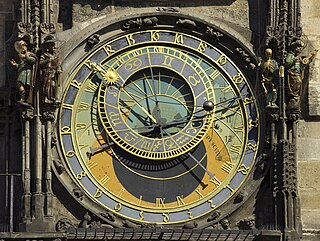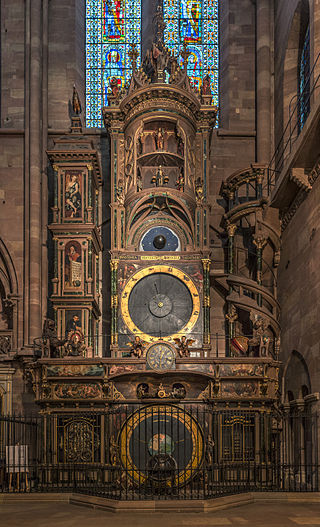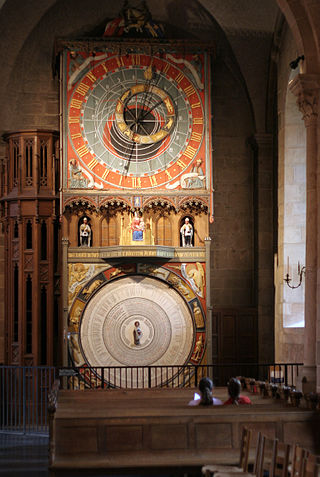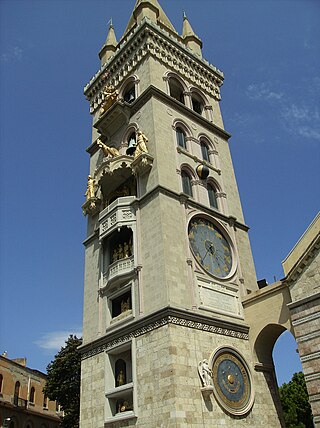
The Beauvais Astronomical Clock is a nineteenth-century astronomical clock in Beauvais Cathedral in northern France. [1]

The Beauvais Astronomical Clock is a nineteenth-century astronomical clock in Beauvais Cathedral in northern France. [1]
The clock was built between 1865 and 1868 by Auguste-Lucien Vérité. It is 12 metres high, and 6 metres wide.
The 52 dials display the times of the rising and setting sun and moon, the position of the planets, the current time in 18 cities around the world, and the tidal times. The clock also displays the epact (i.e. age of the moon in days on January 1) and the golden number used in calculating the date of Easter.
The hours and minutes are shown in the large central face which depicts Jesus Christ and the twelve apostles.
An 1886 edition of Blackwood's Edinburgh Magazine remarks that: "In the eyes of the neighbourhood the chief wonder of Beauvais is not the cathedral, but the astronomical clock...The mechanical part is admirable. It tells everything which any one can wish to know." [2]

An orrery is a mechanical model of the Solar System that illustrates or predicts the relative positions and motions of the planets and moons, usually according to the heliocentric model. It may also represent the relative sizes of these bodies; however, since accurate scaling is often not practical due to the actual large ratio differences, a subdued approximation may be used instead. Though the Greeks had working planetaria, the first orrery that was a planetarium of the modern era was produced in 1713, and one was presented to Charles Boyle, 4th Earl of Orrery – hence the name. They are typically driven by a clockwork mechanism with a globe representing the Sun at the centre, and with a planet at the end of each of the arms.

Beauvais is a town and commune in northern France, and prefecture of the Oise département, in the Hauts-de-France region, 75 kilometres north of Paris.

Clock towers are a specific type of structure that house a turret clock and have one or more clock faces on the upper exterior walls. Many clock towers are freestanding structures but they can also adjoin or be located on top of another building. Some other buildings also have clock faces on their exterior but these structures serve other main functions.

An astronomical clock, horologium, or orloj is a clock with special mechanisms and dials to display astronomical information, such as the relative positions of the Sun, Moon, zodiacal constellations, and sometimes major planets.

The Cathedral of Saint Peter of Beauvais is a Catholic church in the northern town of Beauvais, Oise, France. It is the seat of the Bishop of Beauvais, Noyon and Senlis.

Bourges Cathedral is a Roman Catholic church located in Bourges, France. The cathedral is dedicated to Saint Stephen and is the seat of the Archbishop of Bourges. Built atop an earlier Romanesque church from 1195 until 1230, it is largely in the Classic Gothic architectural style and was constructed at about the same time as Chartres Cathedral. The cathedral is particularly known for the great size and unity of its interior, the sculptural decoration of its portals, and the large collection of 13th century stained glass windows. Owing to its quintessential Gothic architecture, the cathedral was declared a UNESCO World Heritage Site in 1992.

The Strasbourg astronomical clock is located in the Cathédrale Notre-Dame of Strasbourg, Alsace, France. It is the third clock on that spot and dates from the time of the first French possession of the city (1681–1870). The first clock had been built in the 14th century and the second in the 16th century when Strasbourg was a Free imperial city of the Holy Roman Empire.

The Besançon astronomical clock is housed in Besançon Cathedral. Auguste-Lucien Vérité of Beauvais designed and built Besançon's present astronomical clock, between 1858 and 1863. It replaced an earlier clock that Bernardin had constructed in the 1850s that proved unsatisfactory. Besançon's clock differs from those in Strasbourg, Lyon, and Beauvais. The clock is meant to express the theological concept that each second of the day the Resurrection of Christ transforms the existence of man and of the world.

The Passemant astronomical clock is an astronomical clock designed by Claude-Simeon Passemant in the eighteenth century. It is displayed in the Salon de la pendule in the petit appartement du roi on the first floor of Versailles, France. The clock set the official time in France for the first time in the kingdom's history.

The Exeter Cathedral Astronomical Clock is a fifteenth-century astronomical clock in Exeter Cathedral, England. It displays the hour of the day, the day of the lunar month and the phase of the moon. The modern clock mechanism was installed in 1885 by Gillett & Bland of Croydon, and restored in 1910.

Wimborne Minster astronomical clock is a fourteenth-century astronomical clock in Wimborne Minster in Dorset, regarded as "one of the most ancient working clocks in Europe."

Lund astronomical clock, occasionally and at least since the 16th century referred to as Horologium mirabile Lundense, is a 15th-century astronomical clock in Lund Cathedral. Mentioned in written sources for the first time in 1442, it was probably made and installed sometime around 1423–1425, possibly by Nikolaus Lilienfeld. It is part of a group of related medieval astronomical clocks found in the area around the south Baltic Sea. In 1837 the clock was dismantled. Between 1909 and 1923, it was restored by the Danish clockmaker Julius Bertram-Larsen and the Swedish architect responsible for the upkeep of the cathedral, Theodor Wåhlin. From the old clock, the face of the clock as well as the mechanism, which was largely replaced during the 18th century, was salvaged and re-used. The casing, most parts of the calendar which occupies the lower part, and the middle section were made anew.

Ottery St Mary Astronomical Clock is a 14th-century astronomical clock in St Mary's Church, Ottery St Mary, in Devon in south-west England.
The Lyon astronomical clock is a seventeenth-century astronomical clock in Lyon Cathedral.

The Ploërmel Astronomical Clock is a 19th-century astronomical clock in Ploërmel in Brittany, in north-west France.

The astronomical clock of Messina is an astronomical clock constructed by the Ungerer Company of Strasbourg in 1933. It is built into the campanile of Messina Cathedral.

The Zytturm is a 13th-century tower in Zug, Switzerland, which houses an astronomical clock. The tower, which is 52 metres high, is located on Kolinplatz in the old town centre.

A computus clock is a clock equipped with a mechanism that automatically calculates and displays, or helps determine, the date of Easter. A computus watch carries out the same function.

The Münster astronomical clock is an astronomical clock in Münster Cathedral in Münster, Germany.
The Bourges astronomical clock is an astronomical clock in Bourges Cathedral in Bourges, France.